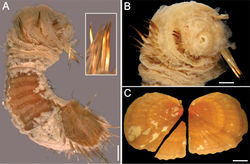Sternaspis rietschi
| Notice: | This page is derived from the original publication listed below, whose author(s) should always be credited. Further contributors may edit and improve the content of this page and, consequently, need to be credited as well (see page history). Any assessment of factual correctness requires a careful review of the original article as well as of subsequent contributions.
If you are uncertain whether your planned contribution is correct or not, we suggest that you use the associated discussion page instead of editing the page directly. This page should be cited as follows (rationale):
Citation formats to copy and paste
BibTeX: @article{Sendall2013ZooKeys286, RIS/ Endnote: TY - JOUR Wikipedia/ Citizendium: <ref name="Sendall2013ZooKeys286">{{Citation See also the citation download page at the journal. |
Ordo: Canalipalpata
Familia: Sternaspidae
Genus: Sternaspis
Name
Sternaspis rietschi Caullery, 1944 – Wikispecies link – Pensoft Profile
- Sternaspis rietschi Caullery, 1944: 68–70, fig. 54a–c; Bleeker and van der Spoel 1992[1]: 159.
Type material
Indonesia. Holotype (ZMA 1500), west of Wokam Island, 5°46'S, 134°00'E, 1788 m, 1899–1900, Stn. 271.
Description
Holotype (ZMA 1500) damaged; integument removed from several body regions; ventro-caudal shield previously removed. Introvert without integument over the first chaetigers, abdomen with integument and body wall broken laterally. Body papillae difficult to determine due to the poor condition of holotype (Fig. 12A). Body 18 mm long, 5 mm wide, about 29 segments.
Prostomium hemispherical, opaque, tan in colour. Peristomium rounded, slightly raised at position of the mouth, without papillae. Mouth oval, covered by papillae, extends from anterior edge of segment 2 almost to prostomium (Fig. 12B).
First three chaetigers with about six to ten large, and five or more smaller, bronze, widely separated, slightly falcate hooks; each with subdistal darker area (Fig. 12A, B). Genital papillae flattened, short protrude ventrally from intersegmental groove between segments 7 and 8. Pre-shield region with 7 segments, without fine capillary chaetae.
Ventro-caudal shield previously removed, broken into three pieces; surface pale brown; ribs barely visible, concentric lines visible; suture probably indistinct (Fig. 12C). Anterior margins rounded; anterior depression shallow; anterior keels probably not exposed. Lateral margins medially expanded, reduced posteriorly. Fan truncate, margin crenulated, median notch shallow, or indistinct (shield plates previously separated).
Marginal shield chaetal fascicles include ten lateral ones, chaetal pattern unknown, and five posterior fascicles, chaetal pattern unknown. Peg chaetae short, with a broad base in cross section, emerge from cuticle on a slightly raised mound. Additional chaetae delicate, between peg chaetae and first bundle of posterior chaetae.
Branchiae lost; nature of branchial plates not determined.
Remarks
The holotype is in poor condition with most of the cuticle missing, exposing the musculature below. It is a large specimen which exaggerates some of the features such as those of the shield and colouring of the introvert hooks. Caullery reported 16 chaetal fascicles in total with 8 located posteriorly; however, because the shield was separated, it appears he counted the groups of chaetae as they appeared under the shield. Further it would have been difficult to determine correctly whether the delicate fine group is part of posterior or lateral fascicles.
The shield of Sternaspisrietschi has a posterior margin straight, at same level as margin of shield resembling Sternaspis princeps, Sternaspis spinosa, Sternaspis thalassemoides and Sternaspis thorsoni sp. n. As indicated above, Sternaspis spinosa differs from the others in that its shield is much wider than long and by having exposed its anterior keels. Further, Sternaspis thorsoni has more abundant, straw-coloured, delicate introvert hooks, whereas the remaining species have fewer, thicker, darker hooks. Also, there are no concentric lines on the shield of Sternaspis princeps in contrast to Sternaspis thalassemoides and Sternaspis rietschi. These two species differ because in Sternaspis rietschi the shield lateral margins are rounded, markedly expanded medially, whereas in Sternaspis thalassemoides they are rather straight, not markedly expanded medially.
Distribution
Only known from the type locality, off Wokam Island, Indonesia, in about 1788 m depth.
Taxon Treatment
- Sendall, K; Salazar-Vallejo, S; 2013: Revision of Sternaspis Otto, 1821 (Polychaeta, Sternaspidae) ZooKeys, 286: 1-74. doi
Other References
- ↑ Bleeker J, van der S (1992) Catalogue of the Polychaeta collected by the Siboga Expedition and type specimens of Polychaeta in the Zoological Museum of Amsterdam. Bulletin Zoölogisch Museum, Universiteit van Amsterdam 13: 121-166.
Images
|
